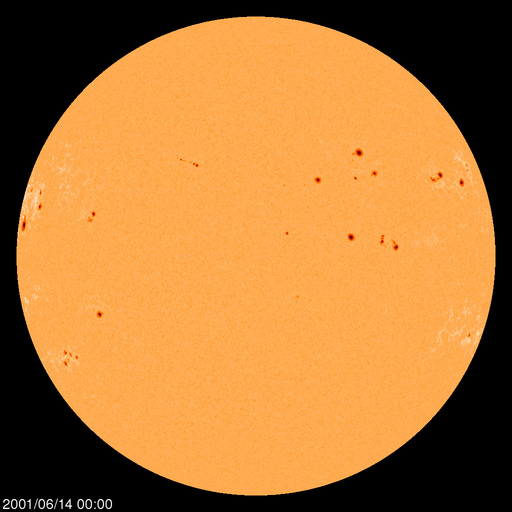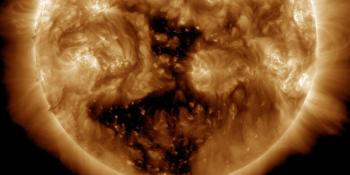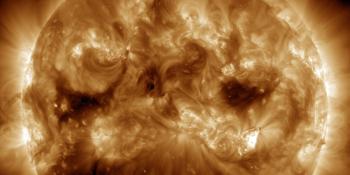Viewing archive of Thursday, 14 June 2001 - Sunspot regions

Courtesy of SDO, SOHO (NASA) and the [MDI, AIA, EVE, and/or HMI] consortium.
| Sunspot number | New regions | Background flux | Maximum flux | C |
|---|---|---|---|---|
| 273 52 | 2 | C2.14 | C9.4 | 5 |
Sunspot regions
Region 9487 |
||||
|---|---|---|---|---|
| Number of sunspots |
Size | Class Magn. | Class Spot | Location |
| 4 1 | 120 | DAO | N22W68 | |
Region 9488 |
||||
|---|---|---|---|---|
| Number of sunspots |
Size | Class Magn. | Class Spot | Location |
| 1 -1 | 60 20 | HSX | S18W70 | |
Region 9489 |
||||
|---|---|---|---|---|
| Number of sunspots |
Size | Class Magn. | Class Spot | Location |
| 4 -5 | 90 -10 | DAO | N20W55 | |
Solar flares on this day | ||||
| C4.99 C9.4 | ||||
Region 9491 |
||||
|---|---|---|---|---|
| Number of sunspots |
Size | Class Magn. | Class Spot | Location |
| 4 1 | 100 | CSO | N27W27 | |
Region 9492 |
||||
|---|---|---|---|---|
| Number of sunspots |
Size | Class Magn. | Class Spot | Location |
| 5 | 80 -20 | DAO | N21W28 | |
Region 9493 |
||||
|---|---|---|---|---|
| Number of sunspots |
Size | Class Magn. | Class Spot | Location |
| 3 | 100 10 | FAO | N07W15 | |
Region 9494 |
||||
|---|---|---|---|---|
| Number of sunspots |
Size | Class Magn. | Class Spot | Location |
| 2 -3 | 120 -200 | HSX | S07W88 | |
Region 9495 |
||||
|---|---|---|---|---|
| Number of sunspots |
Size | Class Magn. | Class Spot | Location |
| 8 5 | 30 20 | CRO | N05W34 | |
Solar flares on this day | ||||
| C6.41 | ||||
Region 9497 |
||||
|---|---|---|---|---|
| Number of sunspots |
Size | Class Magn. | Class Spot | Location |
| 4 -1 | 20 | CRO | S10W12 | |
Region 9498 |
||||
|---|---|---|---|---|
| Number of sunspots |
Size | Class Magn. | Class Spot | Location |
| 4 2 | 60 30 | DSO | N23E18 | |
Region 9499 |
||||
|---|---|---|---|---|
| Number of sunspots |
Size | Class Magn. | Class Spot | Location |
| 4 -2 | 60 20 | DSO | N19W12 | |
Region 9500 |
||||
|---|---|---|---|---|
| Number of sunspots |
Size | Class Magn. | Class Spot | Location |
| 6 3 | 60 -10 | CAO | N09E43 | |
Region 9501 |
||||
|---|---|---|---|---|
| Number of sunspots |
Size | Class Magn. | Class Spot | Location |
| 2 1 | 90 30 | CAO | S15E42 | |
Region 9502 |
||||
|---|---|---|---|---|
| Number of sunspots |
Size | Class Magn. | Class Spot | Location |
| 5 2 | 150 10 | DSO | S26E58 | |
Region 9503 |
||||
|---|---|---|---|---|
| Number of sunspots |
Size | Class Magn. | Class Spot | Location |
| 4 | 160 | CSO | N13E68 | |
Region 9504 |
||||
|---|---|---|---|---|
| Number of sunspots |
Size | Class Magn. | Class Spot | Location |
| 1 | 140 | HSX | N06E76 | |
All times in UTC
Current data suggests there is a slight possibility for aurora to appear at the following high latitude regions in the near future
NuukLatest news
Latest forum messages
AR4043 9Large Coronal Hole 25 132Aurora photography hints for those of us with smartphones 43Photographing auroras 34More on an art than a science 3
More topicsSupport SpaceWeatherLive.com!
A lot of people come to SpaceWeatherLive to follow the Sun's activity or if there is aurora to be seen, but with more traffic comes higher server costs. Consider a donation if you enjoy SpaceWeatherLive so we can keep the website online!

Latest alerts
00:33 UTC - Radio Blackout
Minor R1 radio blackout in progress (≥M1 - current: M1.71)
Wednesday, 26 March 2025
23:00 UTC - Geomagnetic activity
Minor G1 geomagnetic storm (Kp5) Threshold Reached: 22:37 UTC
20:30 UTC - Geomagnetic activity
Moderate G2 geomagnetic storm (Kp6) Threshold Reached: 20:08 UTC
20:15 UTC - Geomagnetic activity
Minor G1 geomagnetic storm (Kp5) Threshold Reached: 20:00 UTC
18:00 UTC - Geomagnetic activity
Moderate G2 geomagnetic storm (Kp6) Threshold Reached: 17:00 UTC
Space weather facts
| Last X-flare | 2025/02/23 | X2.0 |
| Last M-flare | 2025/03/26 | M1.0 |
| Last geomagnetic storm | 2025/03/22 | Kp6- (G2) |
| Spotless days | |
|---|---|
| Last spotless day | 2022/06/08 |
| Monthly mean Sunspot Number | |
|---|---|
| February 2025 | 154.6 +17.6 |
| March 2025 | 135 -19.6 |
| Last 30 days | 133.8 -19.2 |






